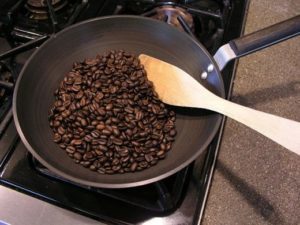Cook delicious coffee - an easy task for an amateur and baristas. With no experience, it is easy to waste time, the soil all over the dishes, disappointed and left without a tasty beverage.
The cooking process is quite simple, but it is important to know some details that affect the taste of the finished beverage.
Coffees and the degree of roasting beans
The content of the article
- Coffees and the degree of roasting beans
- Types of grinding coffee beans
- Pray for locust bean coffee makers
- Grind for drip coffee makers
- Grinding for geyser coffee makers
- Experiments with roasting and grinding coffee
 The amount of nearly a hundred varieties. Each country, each area can be several of them. But all of them can be attributed to the few species. The most popular is Arabica. It has a mild and rich taste.
The amount of nearly a hundred varieties. Each country, each area can be several of them. But all of them can be attributed to the few species. The most popular is Arabica. It has a mild and rich taste.
In second place on the popularity of Robusta. It contains much more caffeine, which gives an extra bitterness. Most of the grown Robusta are processed into instant coffee. Robusta coffee beans and ground into small shops.
On sale you can find blends consisting of Arabica and Robusta in different proportions.
Arabica and Robusta occupy more than 95% of the coffee market. The remaining share is still on the rare species, which are mainly used as additives in certain grades. The most famous among these curiosities are Liberica and Ekstselza. As an independent drinks they are very bitter and not popular even among the population engaged in their cultivation.
Roast have different classifications are isolated from the base 4 to 10 degrees:
- light - medium - dark - the highest;
- Scandinavian weakest (cinnamon) - US (New England) - urban (partial) - complete city - Vienna (velvet, corduroy, business) - French (Turkish) - Continental (European, New Orleans) - Spanish (Mexican, Cuban) - Italian, the highest (Indian, Neapolitan).
As the degree of roasting in the taste:
- weakened varietal characteristics, acidity;
- enhanced flavor, richness, bitterness.
Knowing the described species and patterns, easier to navigate in the abundance of offerings. The choice depends on personal preference, find out which is possible only through a tasting.
Types of grinding coffee beans
 Grindings basic three:
Grindings basic three:
- rudeHe is a large, similar in structure to sugar;
- average - a particle size comparable with semolina;
- thin - small, smaller than the decoys.
Fine grinding, in turn, can be ultra-thin, and dusty.
There are recommendations on the choice of grinding for each type of coffee maker.
Pray for locust bean coffee makers
Traditionally used secondary crushed powder. It is well pressed into a tablet and does not clog the holes horn.
Coffee machines, high pressure jet of steam (15 bar) permit the use Pulver pulverisation. The drink is obtained especially saturated and aromatic.
Important! To effectively compressing tablets horn powder should be uniform.
Grind for drip coffee makers
 When using a strainer grinding should be close to the particles do not fall into the cup and is not stuck in the filter holes.
When using a strainer grinding should be close to the particles do not fall into the cup and is not stuck in the filter holes.
Paper filters securely retain any pellet fraction allow any brew raw material grinding. The larger it is, the easier it taste more pronounced acidity. The thinner - the greater the intensity, more pronounced bitterness in the taste.
Grinding for geyser coffee makers
Suitable secondary and prominent crushing. Such coffee does not prevent the ingress of water from the bottom to the top. Taste is obtained to the extent of complete, not bitter.
If you wish to receive more intense drink, it is permissible to use finely ground powder. However, the drink will be thick, the particles of coffee can get into the cup.
Experiments with roasting and grinding coffee
 For some models of coffee makers is contraindicated fine milling due to the possible formation of excessive water obstructed, it is written in the manual. The rest of the experiments are limited only by your imagination.
For some models of coffee makers is contraindicated fine milling due to the possible formation of excessive water obstructed, it is written in the manual. The rest of the experiments are limited only by your imagination.
Existing recommendations on the choice of coffee account for the most popular taste preferences. You can try various combinations of the characteristics described above In search of perfect taste.
Important! Regardless of the type of coffee roasting and grinding it, the taste and flavor of the beverage powder, ground directly before cooking, advantageously differ from the pre-ground. In the absence of milled grain prior to each cooking, Pulver must be stored in tightly closed containers.
